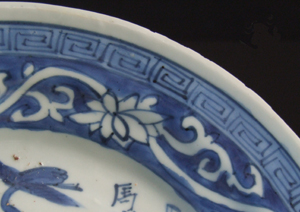
TIANQI 1621 – 1627 Ming Porcelain
A Rare Inscribed Ming Blue and White Porcelain Dish, Transitional Period, Tianqi 1621-1627.
- Condition
- In good condition, the rim with mushikui fritting. There is also a small firing crack to the rim at 3 o'clock.
- Size
- Diameter : 22 cm (8 3/4 inches)
- Provenance
- N/A
- Stock number
- 24007
- References
- A dish of this design but with a somewhat different arrangement is illustrated in the book by the late Sir Michael Butler : Late Ming, Chinese Porcelain from the Butler Family Collections (Sir Michael Butler, Museum d`Histoire et d`Art, Luxembourg, 2008. ISBN 978-2-87985-029-0) page 67.
Information
The Central Scene Shows Three Geese in The Foreground with a Fourth Goose Flying Above them, Next to it is a Four Character Inscription Which can be Translated as "May Your Name be Inscribed on the Wall of the Wild Goose Pagoda in Chang`An". The Promontory in the Distance Shows a Pagoda Near Another Building. The Scene Below, Which is Upside Down, has Another Four Line Verse that Give the Impression of a Reflection of the Pagoda Above. This Can Loosely be Translated as "May You Enjoy the Imperial Spring Banquet in the Apricot Grove". The Flowering Plant Next to this Inscription is Apricot with Three Swallows Flying Above. The Indented Cavetto is Painted with a Scrolling Lotus Against a Blue Ground. The Outer Border is of Greek Key Against a Pale Blue Ground.
The first inscription "May Your Name be Inscribed on the Wall of the Wild Goose Pagoda in Chang`An" relates to a custom started in the Tang Dynasty (618-907). Successful candidates for the highest level of the Jinshi civil service examination had their names inscribed on the wall of the Wild Goose Pagoda in the old Tang capital Chang`an. The second inscription "May You Enjoy the Imperial Spring Banquet in the Apricot Grove" refers to the banquet held near the Wild Goose Pagoda. This inscription is reinforced through a rebus involving spring swallows and apricot blossom. This information comes from the book mentioned below by the late Sir Michael Butler, a man who has totally changed the way we see porcelain from the Transitional period. He will be very much missed.





